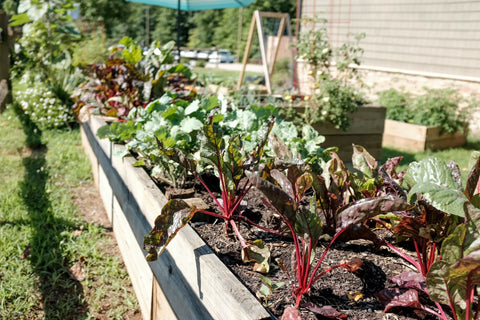As the vibrant colors of summer start to fade and the days grow shorter, it's time to turn your attention to fall lawn care. While it might seem like your lawn is winding down for the year, the truth is that the care you provide in the fall can have a profound impact on the health and appearance of your grass come spring. In this comprehensive guide, we'll explore essential fall lawn care tips and practices that will help you achieve lush, green grass when the warm weather returns.The following content also has some reference value for raised garden beds.
Why Fall Lawn Care Matters
Fall is a critical period for your lawn. The cooler temperatures and more abundant moisture create ideal conditions for grass growth and root development. By focusing on proper care during this season, you'll set the stage for a healthier, more resilient lawn in the following spring. Here are some reasons why fall lawn care matters:
Root Growth
- During the fall, grass shifts its energy from top growth to root growth. Strong, deep roots are essential for a healthy lawn.
Weed and Pest Control
- Fall is an opportune time to address weed and pest issues. Treating these problems in the fall can prevent them from becoming more severe in the spring.
Thicker Grass
- By providing the right care in the fall, you encourage your grass to thicken, which can help choke out weeds and create a lush, green lawn.
Resilience
- A well-cared-for lawn in the fall is better equipped to withstand the challenges of winter, such as freezing temperatures and snow cover.
Now, let's dive into the specific steps and practices that will help you achieve a beautiful, healthy lawn in the fall and beyond.
1. Mowing
Aim for the Right Height
- Adjust your mower blade to maintain a grass height of around 2.5 to 3 inches. Taller grass shades the soil, which helps retain moisture and prevent weed growth.
Regular Mowing
- Continue to mow your lawn regularly as long as it's growing. Never cut more than one-third of the grass' height all at once.
2. Aeration
Core Aeration
- Consider core aerating your lawn in the fall. This process involves removing small plugs of soil to relieve compaction and allow nutrients and water to penetrate the root zone.

Overseeding
- After aerating, overseed your lawn with a cool-season grass blend suitable for your region. This helps fill in thin areas and encourages a denser lawn.
3. Fertilizing
Balanced Fertilizer
- Apply a balanced, slow-release fertilizer with a ratio of nitrogen, phosphorus, and potassium appropriate for your grass type. This provides essential nutrients for fall growth and winter hardiness.
Avoid Excess Nitrogen
- While fertilizing is crucial, avoid using excessive nitrogen in the fall, as it can lead to rapid, weak growth that's susceptible to winter damage.
4. Weed Control
Weed Identification
- Identify and address any persistent weeds. Consider using a broadleaf herbicide to target weeds while sparing your grass.
Pre-Emergent Herbicide
- Apply a pre-emergent herbicide to prevent the germination of winter annual weeds like chickweed and henbit.
5. Watering
Deep Watering
- Continue watering your lawn deeply and less frequently to encourage deep root growth. Aim for roughly 1 inch of water every week, including rainfall.
Morning Watering
- Water your lawn in the morning to allow sufficient time for the grass to dry before evening, reducing the risk of fungal diseases.
6. Leaf Removal
Regular Leaf Removal
- Keep your lawn clear of fallen leaves. A thick layer of leaves can smother the grass and create ideal conditions for disease.
Composting Leaves
- Instead of discarding leaves, consider composting them. Leaf compost makes an excellent natural fertilizer for your lawn and garden.
7. Lawn Equipment Maintenance
Winterize Equipment
- Prepare your lawn equipment for winter storage. Clean and sharpen mower blades, and properly store tools to prevent rust.

8. Soil Testing
Know Your Soil
- Consider conducting a soil test to understand your lawn's specific nutrient needs. This will help you tailor your fertilization strategy.
9. Lawn Renovation
Address Bare Spots
- If you have bare or thin areas in your lawn, fall is an excellent time to address them. Prepare the soil, sow grass seed, and keep the area consistently moist.
10. Dethatching
Thatch Removal
- If your lawn has a thatch problem (a layer of dead grass and debris), consider dethatching in the fall. This improves water and nutrient penetration.
11. Pest Control
Grub Prevention
- Apply a grub control product if your area is prone to white grub infestations. Preventing grubs in the fall helps protect your lawn from damage in the spring.
12. Lawn Diseases
Monitor for Diseases
- Keep an eye out for signs of lawn diseases like brown patch or dollar spot. Address these issues promptly with appropriate treatments.
13. Snow Removal
Gentle Snow Removal
- When snowfall occurs, use gentle methods for snow removal. Avoid heavy equipment that can damage the grass beneath.
14. Winter Protection
Cold-Weather Preparations
- Before the first frost, consider applying a winterizing fertilizer to help your grass endure the cold months.

Conclusion: A Beautiful Lawn, Season After Season
Caring for your lawn in the fall isn't just about preparing for the colder months; it's an investment in the long-term health and beauty of your grass. By following these fall lawn care tips and practices, you'll nurture a lawn that's not only resilient but also lush and vibrant come spring. So, roll up your sleeves, grab your rake, and let your fall lawn care routine set the stage for a picturesque landscape in the seasons to come. Your efforts will be rewarded with a carpet of healthy, green grass that you, your family, and your neighbors can enjoy year-round.









